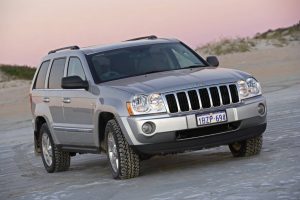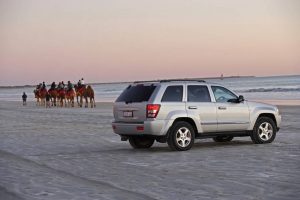Recalls: Jeep WH Grand Cherokee
Overview
Manufacturers, or importers, issue recalls for defects or faults which have the potential to cause injury. Generally, manufacturers will inform the original buyers if their vehicle is subject to a recall and of the steps required to remedy the defect or fault. Please note that the recalls below (if any) are for Australian-delivered vehicles only. Furthermore, the number of recalls should not be taken as an indication of a model’s reliability or its safety more generally.
Recalls: Jeep WH Grand Cherokee
- In March 2007, a recall was issued for Jeep WH Grand Cherokee vehicles that were manufactured from 11 October 2006 to 23 November 2006 (MDH 101100-112323). In these vehicles, the software programmed into the Anti-Lock Brake System (ABS) control module may cause the rear wheels to lock up under certain braking conditions (PRA 2007/9086).
- In November 2007, a recall was issued for model year 2006 to 2007 Jeep WH Grand Cherokee vehicles due to incorrect software programming for the Electronic Brake Control (EBC) module. As a result, there could be a momentary delay in braking when coasting up-hill, increasing the vehicle’s stopping distance (PRA 2007/9686).
- In January 2008, a recall was issued for model year 2007 to 2008 Jeep WH Grand Cherokee models due to the front brake calipers potentially being incorrectly manufactured. As such, they were vulnerable to breakage under certain conditions, increasing the vehicle’s stopping distance (PRA 2008/9755).
- In November 2010, a recall was issued for WH Grand Cherokee vehicles. In these vehicles, the windshield wiper motor may fail without warning – this could limit the driver’s visibility in certain driving conditions (PRA 2010/12926).
- In May 2013, a recall was issued for WH Grand Cherokee vehicles for potentially inadvertent gearshifts into neutral on start-up as a result of circuit boards transmitting compromised signals (PRA 2013/13578).
- In October 2014, a recall was issued for Jeep WH Grand Cherokee vehicles that were manufactured from 2005 to 2007. In these vehicles, the ignition switch may change position while driving. If this occurred, there may be a loss of engine power, power steering assist and brake assistance, thereby increasing the risk of a crash and disabling one of more of the vehicle’s safety features, including the frontal airbags (PRA 2014/14363).
- In November 2014, a recall was issued for 2008 Jeep WH Grand Cherokee vehicles because the Frequency Operated Button Ignition Key (FOBIK) may stick between the ‘Start’ and ‘Run’ position. If this occurred, the vehicle may experience a loss of engine power, power steering assistance and/or brake booster assistance. Furthermore, the FOBIK spring back may also cause one or more of the vehicle’s safety features to be disabled, including the frontal airbags. The loss of any of these features could increase the risk of a crash and injury to vehicle occupants (PRA 2014/14440).
Problems and faults: Jeep WH Grand Cherokee
Overview
This section identifies potential problems, causes and fixes based on the experiences of owners and repairers, online sources and technical service bulletins. This information is provided solely for reference purposes and AustralianCar.Reviews recommends that only properly qualified persons carry out repairs or modifications. Furthermore, the number of items below should not be taken as an indicator of a model’s reliability or the frequency with which they may occur.
To report a problem or fault to the AustralianCar.Reviews team, please use the Contact Us form. Note that AustralianCar.Reviews does not offer advice on automotive problems or disputes; such enquiries will not receive a reply. For vehicles purchased from dealers after 1 January 2011, please see our Australian Consumer Law fact sheet.
Jeep WH Grand Cherokee: Transmission Fluid Leaks
In May 2005, Technical Service Bulletin (TSB) 21-002-05 REV A was issued for 2005 Jeep WH Grand Cherokee vehicles with the NAG1 automatic transmission (sales code DGJ or DGU). In these vehicles, automatic transmission fluid (ATF) may weep or leak from the right front corner of the transmission oil pan due to failed O-rings at the electrical connector.
Despite the production years given above, it is understood that later models were also affected. Subsequent to the TSB being issued, it is recommended that the plug adapter be replaced in addition to the O-rings.
Additionally, the ‘check engine’ light may illuminate due to leaks from the transmission solenoid/pressure switch. If so, the solenoid and electrical connector require replacement.
Jeep WH Grand Cherokee 3.0L Diesel: DTC P1270
In September 2007, Technical Service Bulletin (TSB) 09-002-07 was issued for 2005-06 Jeep WH Grand Cherokee vehicles with 3.0-litre turbo-diesel engines (engine sales code: EXL). In these vehicles, the swirl chamber linkage clips which are located in each runner of the intake manifold may bind, causing Diagnostic Trouble Code (DTC) P1270, ‘Intake Manifold Runner Swirl Performance’ to be issued. To fix, the mechanical clips for the intake manifold runner swirl valve linkage were to be replaced.
Jeep WH Grand Cherokee 3.0L Diesel: DTC P1270
In September 2009, Technical Service Bulletin (TSB) 14-001-09 REV A was issued for 2005-09 Jeep WH Grand Cherokee vehicles with petrol engines. For these vehicles, the owner may experience difficulties when re-fuelling or the fuel pump nozzle may shut off repeatedly during re-fuelling. For these vehicles, the TSB described a diagnosis procedure which may identify the source of the problem as:
- The fuel filler tube;
- The vapour recirculation tube;
- The fuel tank itself;
- A blockage in the EVAP canister, ESIM, clean air hose or filter; or,
- The control valve to the EVAP canister tube.
Jeep WH Grand Cherokee: Other problems and faults
- The Jeep Grand Cherokee’s engine may fail to crank or start due to an electronics failure of the wireless control module and electric steering column lock.
- A growling sound from the air conditioning compressor as it cycles on or off may require the expansion valve to be replaced.
- The steering column may make a clicking noise due to interference between the turn signal lever and the cancel cam.
- For some early models, a whining noise may come from the power steering system – particularly in cold conditions – when first started due to insufficient fluid flow; a revised power steering fluid reservoir was subsequently released to fix this problem.
- The transmission may provide delayed gear engagement after cold soak due to a filter in the transmission fluid cooler line allowing the torque converter to drain down; a revised filter was subsequently released.
- The ‘express up’ function of the windows may reverse, causing the windows to go down – this is due to a malfunctioning window regulator. If, however, the ‘express up’ has no effect, the windows may not close due to pinching by the tracks, loose hardware or sticking due to ice.




